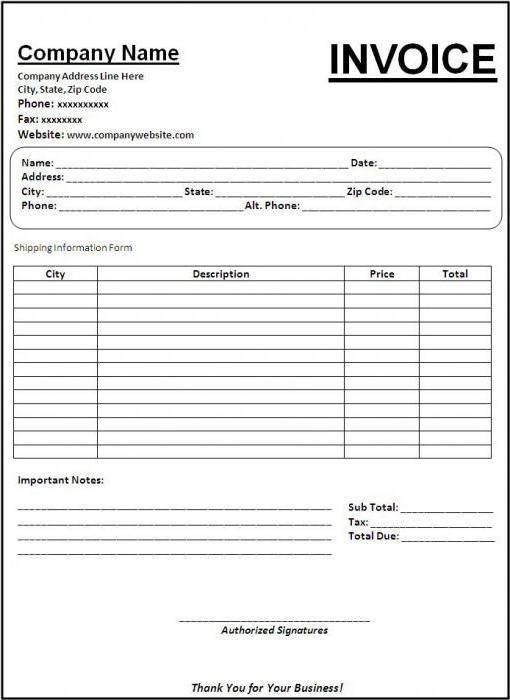Accountants often have doubts about how to properly issue an invoice and when it should be noted in accounting books. Let's see what this document is and how to use it.
An invoice is a distributed document, according to which both payment for the goods and tax deduction are charged. In international accounting, this document looks like this:

What the Tax Code Says
According to the Tax Code, the period for issuing an invoice is limited to 5 business days — in fact, one week. This period is counted as follows:
- on the day of receipt of advance payment (wholly or wholly) in respect of further deliveries or transfer of ownership;
- on the day of the actual shipment of the goods (provision of services or performance of work), transfer of ownership.
The five-day period is considered from the day following the date of the first shipment. If the invoice was issued for work or the provision of services, the deadline for invoicing is calculated from the date of full provision of the work or services. Please note: this is not about starting work, but about the full provision of the agreed services or work. The exception is cases when the work will be done on an advance payment and this circumstance is expressly indicated in the economic contract. In this case, an advance invoice is issued to the counterparty. The deadline for issuing these documents is five days from the date of receipt of money in the account.
Working days and days off
It happens that the deadline for issuing falls on a non-working day. In this case, Art. 6.1 of the Tax Code allows the seller to postpone the invoice by the first working day after a five-day period. But this norm should be used very carefully, since even a one-day delay will lead to the fact that the invoice will not be counted at the next tax audit. Therefore, auditors and experienced chief accountants recommend invoicing in this case in advance, without waiting for the end of the five-day period. Billing can be done on the same day that the corresponding business transaction was conducted. If necessary, the invoice can always be adjusted.

Unified Invoices
According to the Tax Code, some commercial enterprises are allowed to issue single (consolidated) invoices for sales based on the results of the reporting month. The right to work on a single account must be fixed in the contract. It is allowed to work in this form to contractors who carry out:
- continuous supply of goods;
- continuously provide transportation or logistics services;
- supply of electricity, fuel resources;
- provide communication services;
- daily and continuously sell goods.
If the counterparties have worked less than 30 calendar days, the invoice should be issued by the time the deadline for delivery. But in this case, inspectors may insist that the principle of regularity and continuity of supply is violated. Therefore, new counterparties with a uniform invoice rate should be approached with caution.
As for the Tax Code, the period for issuing invoices for the reporting month follows within five days of the month following the reporting one. But you need to register such accounts in the month in which the first sales of the goods received were carried out.

Responsibility for failure to meet deadlines
The Penal Code does not indicate penalties for violation of the deadlines for issuing invoices. But, as a rule, inspectors are guided by Art.120 of the Tax Code and is called for late billing, as for non-billing in general. This is especially true for documents that must be created at the junction of two reporting periods. For example, if an invoice should be issued last month, but created only in the current month, inspectors can regard this as a lack of an invoice and fine the company.
Down payments
So far, we have talked about invoices issued for the first event, such as the delivery of goods or the actual presentation of services. And how to write and calculate the deadline for invoicing in advance? How soon should it be submitted to the counterparty?
The timing of advance invoices is directly related to the tax liability of the company. The money received by the company in connection with commercial activity automatically becomes the basis for taxation, and the invoice is a document certifying the correctness of the receipt of money.
If the first event is the receipt of funds in the current account, then the deadline for issuing an invoice in advance begins in the same period and under the same conditions as the invoice for the delivery of goods. Thus, for pre-transferred funds, a tax liability arises within five days after receipt of the money, which should be reflected in the relevant document. These deadlines for issuing advance invoices are fixed in article 164, paragraph 4 of the current Tax Code.

Electronic documents
09/02/2010 The tax service of the Russian Federation recognized the right of taxpayers to work with electronic samples of tax and accounting documents. For the first time, an electronic document is recognized as equivalent and is accepted along with documents on paper. This norm is fixed in paragraph 1 of Art. 169 Tax Code. The deadlines for issuing electronic invoices are similar to the period for holding paper documents, since in this case both paper and virtual documents are identical.
To implement this provision, a separate order of the tax service approved the formats of electronic invoices, journals of accounting for these documents and other books. The procedure for working with such documents is similar to paper workflow. One day is given for each exchange of bills, but actually, thanks to the Internet, the operation takes several seconds. The exchange of accounts is fixed in Order 174 n and consists of the following:
- The date the invoice appears in the counterparty’s accounting is the date the operator receives such a file. Please note: not the invoice date, but the date of receipt by the operator.
- The receipt of electronic VAT invoices, the deadline for issuing these documents is not counted from the date on the document, but from the sending of the invoice to the buyer by the operator. The deadline for invoicing by the seller, therefore, depends not only on the first event, but also on the transmission of an electronic document to the operator.
A proof of receipt of the document may be a notice. Previously, it was a mandatory requisite of an electronic invoice. Now this document is an addition to the account and is executed only in case of additional agreement between counterparties.

Invoice Registration
Accounting of invoices, which are the basis for tax transactions, is carried out in the accounting books. Since January 2015, only tax payers are required to keep such magazines. But there are exceptions to this rule. So, according to existing rules and regulations, the invoice journal should be available:
- with taxpayers;
- persons exempted from the obligation to be a taxpayer;
- persons not registered as taxpayers, if they periodically issue or receive invoices when conducting business, while representing the interests of other persons on the basis of bilateral agreements.
A complete list of the principles for processing and storing these documents is contained in the Rules for maintaining the register of invoices approved in 2011.
The procedure for filling out invoices
According to the Filling Rules, taxpayers have the opportunity to indicate additional information in this document. These include:
- details of the primary document (invoice, bank statement);
- name of the person issuing the invoice with current statutory and settlement details.
Mentioning primary documents enables the seller to indicate additional information not only for sellers, but also for buyers, for example, it is possible to specify the date of acceptance of the goods or the deadline for completion of work, other information of interest to the opposite side. In order to regulate the flow of necessary information, such an addition was allowed.

New changes
In 2017, the document was amended. So, the mandatory requisite is the code of the type of goods TN FEA, which is necessary for the supervision of deductions for the commodity group of goods. In the case of a commodity group, the deduction is accepted in the old order, and in transactions with non-graded goods, the deduction is carried out in the new form. The code of the type of goods TN VVED became mandatory for indicating in the document. This is due to the fact that this code is necessary for monitoring deductions for goods of the commodity group, which are accepted in the old order. All other product groups are drawn up in the current form.

In new accounts, it is necessary to indicate the address that must correspond to the data from the register. Previously, it was enough to specify the details from the constituent documents, now the new rules oblige to make correspondence both in the invoice and in the register of legal entities.
Adjustment Billing
Adjustment invoices are issued if there has been a change in the value of goods, services or work. The size of the changes in this case is indicated in column 5 of the invoice. If the number of units of goods of work or services provided changes, the changes are made in column 3.
Budget and adjustment billing periods
Before learning about the timing of issuing adjustment invoices, it will not be superfluous to familiarize yourself with the contract under which the business of this enterprise is conducted with the counterparty. If the contract indicates the possibility of making changes, then they should be made in a five-day period after approval. Confirmation of such consent can serve as an Act of established discrepancy, certified by both parties.
All tax actions with invoices and corrective invoices relate to the period in which these documents were issued. Based on the adjustment invoice issued in the direction of reducing the total cost of delivery, the supplier has the right to reduce its own tax liabilities. To receive a VAT deduction, the seller forms a negative invoice. Thus, the amount of VAT is reduced by the amount of the full invoice minus the amount of the corrective invoice. The buyer, on the contrary, has an additional obligation to increase his VAT on the basis of the invoice. For electronic invoices, similar requirements apply. The deadline for issuing an electronic format adjustment invoice is the same as for paper documents — within five days after signing the Discrepancy Report.
Correction of errors in invoices
This is possible if the following was found in the invoice:
- an error in the details of the buyer or seller;
- Incorrect tax rate
- simple typo.
If the invoice should be corrected, a new, revised document should be prepared for it. Regardless of when the correction was issued, the corrected invoice is assigned to the same tax period in which the operation was carried out and the initial invoice was drawn up.If the invoice, which was issued with an error, does not lead to a refusal of VAT refunds, then it can not be corrected.
The numbering of the main and corrective invoices within one period is continuous. Corrections to adjustment invoices are prepared in the same way as to the original ones. But the numbering of the corrected accounts within one account always starts with one. An entry is made in the accounting logs: the invoice is such and such, correction No. 1, and it is such an account that should be taken into account when calculating VAT.